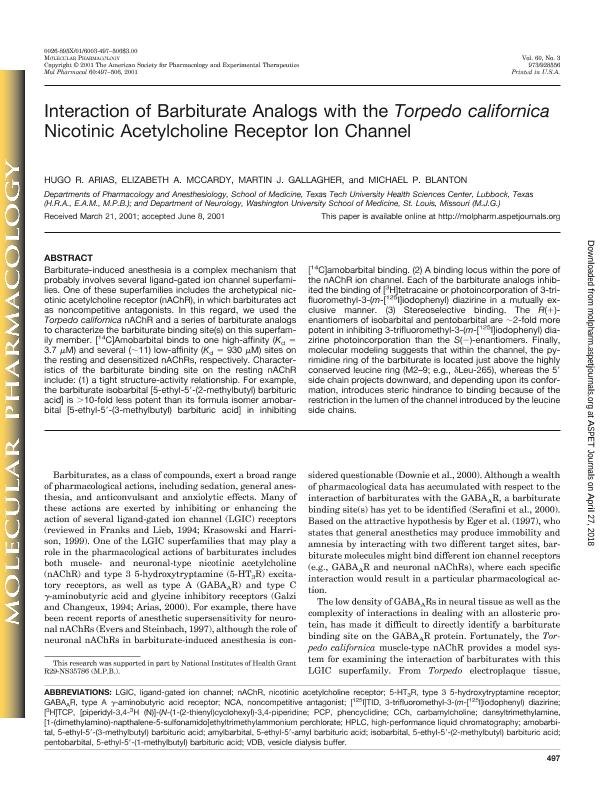Mostrar el registro sencillo del ítem
dc.contributor.author
Arias, Hugo Rubén

dc.contributor.author
McCardy, Elizabeth A.
dc.contributor.author
Gallagher, Martín J.
dc.contributor.author
Blanton, Michael P.
dc.date.available
2019-06-25T13:01:03Z
dc.date.issued
2001-09
dc.identifier.citation
Arias, Hugo Rubén; McCardy, Elizabeth A.; Gallagher, Martín J.; Blanton, Michael P.; Interaction of Barbiturate Analogs with the Torpedo californica Nicotinic Acetylcholine Receptor Ion Channel; American Society for Pharmacology and Experimental Therapeutics; Molecular Pharmacology; 60; 3; 9-2001; 497-506
dc.identifier.issn
0026-895X
dc.identifier.uri
http://hdl.handle.net/11336/78778
dc.description.abstract
Barbiturate-induced anesthesia is a complex mechanism that probably involves several ligand-gated ion channel superfamilies. One of these superfamilies includes the archetypical nicotinic acetylcholine receptor (nAChR), in which barbiturates act as noncompetitive antagonists. In this regard, we used the Torpedo californica nAChR and a series of barbiturate analogs to characterize the barbiturate binding site(s) on this superfamily member. [14C]Amobarbital binds to one high-affinity (Kd = 3.7 μM) and several (∼11) low-affinity (Kd = 930 μM) sites on the resting and desensitized nAChRs, respectively. Characteristics of the barbiturate binding site on the resting nAChR include: (1) a tight structure-activity relationship. For example, the barbiturate isobarbital [5-ethyl-5′-(2-methylbutyl) barbituric acid] is >10-fold less potent than its formula isomer amobarbital [5-ethyl-5′-(3-methylbutyl) barbituric acid] in inhibiting [14C]amobarbital binding. (2) A binding locus within the pore of the nAChR ion channel. Each of the barbiturate analogs inhibited the binding of [3H]tetracaine or photoincorporation of 3-trifluoromethyl-3-(m-[125I]iodophenyl) diazirine in a mutually exclusive manner. (3) Stereoselective binding. The R(+)-enantiomers of isobarbital and pentobarbital are ∼2-fold more potent in inhibiting 3-trifluoromethyl-3-(m-[125I]iodophenyl) diazirine photoincorporation than the S(−)-enantiomers. Finally, molecular modeling suggests that within the channel, the pyrimidine ring of the barbiturate is located just above the highly conserved leucine ring (M2–9; e.g., δLeu-265), whereas the 5′ side chain projects downward, and depending upon its conformation, introduces steric hindrance to binding because of the restriction in the lumen of the channel introduced by the leucine side chains.
dc.format
application/pdf
dc.language.iso
eng
dc.publisher
American Society for Pharmacology and Experimental Therapeutics

dc.rights
info:eu-repo/semantics/openAccess
dc.rights.uri
https://creativecommons.org/licenses/by-nc-sa/2.5/ar/
dc.subject
Nicotinic Acetylcholine Receptor
dc.subject
Barbiturates
dc.subject
Photoaffinity Labeling
dc.subject
Radioligand Binding
dc.subject.classification
Farmacología y Farmacia

dc.subject.classification
Medicina Básica

dc.subject.classification
CIENCIAS MÉDICAS Y DE LA SALUD

dc.title
Interaction of Barbiturate Analogs with the Torpedo californica Nicotinic Acetylcholine Receptor Ion Channel
dc.type
info:eu-repo/semantics/article
dc.type
info:ar-repo/semantics/artículo
dc.type
info:eu-repo/semantics/publishedVersion
dc.date.updated
2019-06-12T14:22:01Z
dc.journal.volume
60
dc.journal.number
3
dc.journal.pagination
497-506
dc.journal.pais
Estados Unidos

dc.journal.ciudad
Baltimore
dc.description.fil
Fil: Arias, Hugo Rubén. Texas Tech University Health Sciences Center; Estados Unidos. Consejo Nacional de Investigaciones Científicas y Técnicas; Argentina
dc.description.fil
Fil: McCardy, Elizabeth A.. Texas Tech University Health Sciences Center; Estados Unidos
dc.description.fil
Fil: Gallagher, Martín J.. University of Washington; Estados Unidos
dc.description.fil
Fil: Blanton, Michael P.. Texas Tech University Health Sciences Center; Estados Unidos
dc.journal.title
Molecular Pharmacology

dc.relation.alternativeid
info:eu-repo/semantics/altIdentifier/url/http://molpharm.aspetjournals.org/content/60/3/497.long
Archivos asociados
